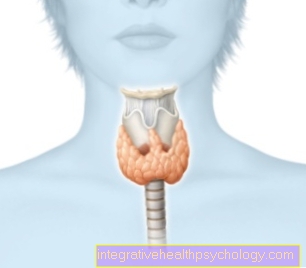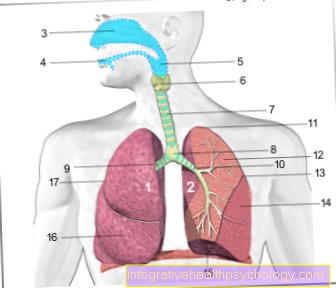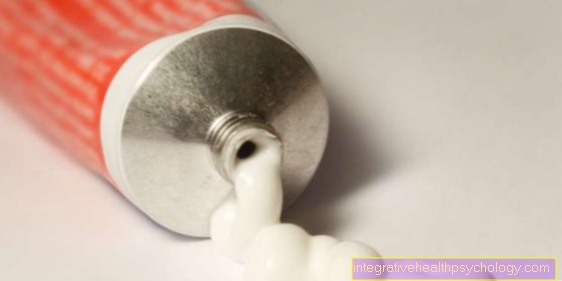Revision of a root canal treatment
introduction
A revision means that, in principle, the root canal treatment is carried out again: The existing (old) root filling material is completely removed and, after careful cleaning of the enlarged root canals, a new root canal filling is inserted.

What is a revision?
Is the tooth nerve diseased (in the case of a Pulp necrosis, Pulpitis or apical periodontal disease), a root canal treatment is usually performed by the dentist to preserve the tooth. Despite very high success rates, the complex structure of the tooth interior may not completely heal the inflammation at the root tip. Then it may be necessary to revise the root canal treatment.
Indication for a revision
Indications for a revision of the root canal treatment are radiological or clinical signs of an existing or newly developed inflammation at the tip of a tooth that has been treated with a root canal. The inflammation is also called Apical periodontal disease and it leads to one Osteolysis (Bone loss) at the tip of the root. This change can be seen on an X-ray.
Once the root canal treatment has been completed, the inflammation should, in the best case, subside and the x-rays during control examinations (about 6 months later) should show a clear decrease in osteolysis.
A revision may also be necessary if pain occurs again in teeth that have been treated with root canals. Pressure pain is often felt on the gums and the jawbone in the area of the tooth roots.
Bite pain can also occur when the tooth is loaded. It can also lead to swelling of the gums or a fistula.
Another indication is an incomplete or inadequate root canal filling, especially if the covering filling is leaking.
How does a root canal revision work?
After a preliminary check and detailed explanation of the patient, the existing root canal filling should be removed as completely as possible. Depending on the root filling material, this is difficult and the success of the revision is not always guaranteed.
Common filling materials such as gutta-percha® can usually be removed quite easily. To do this, either the top filling must be removed or a sufficiently large opening drilled into the crown.
The root canals are then enlarged manually or by machine with so-called endo arrows. They serve to completely remove the inflammatory residual tissue in the tooth. They also ensure thorough cleaning and expansion of the channels.
The use of a microscope can be helpful in assessing and cleaning the root canals.
In addition to mechanical cleaning, chemical cleaning of the root canals should also take place.Rinsing solutions such as sodium hypochlorite, EDTA or chlorhexidine (CHX®) are used for this. It is important to clean and disinfect the entire length of the root canal and to look for any secondary canals or further root canals.
Depending on the condition of the tooth, the revision and the renewed root canal filling can take place in one session, i.e. at one appointment. However, if the treatment is a bit more complex, a drug (e.g. Calcipro®) is first inserted into the tooth. The tooth is then closed with a temporary filling (e.g. Cavit®). The final root canal filling is then carried out at a second appointment. After the treatment, an X-ray will be taken as a control.
Find out more at: Procedure of a root canal treatment
Is a revision of a root canal treatment painful?
When the root canal treatment is revised, there should be no pain in the tooth. The tooth nerve was removed during the first treatment of the original root canal filling.
Nevertheless, the surrounding tissue and bone can be numbed. The surrounding structures can be very tender and painful, especially if there is renewed inflammation. Inflammation at the root tip of the tooth often manifests itself as pressure pain or bite pain when chewing.
You might also be interested in: Pain during root canal treatment
Follow-up treatment for a revision
After a revision of the root canal treatment, regular follow-ups should take place. An X-ray is often taken during the controls. The decrease in inflammation can be observed on the basis of the X-ray.
It can take some time to see the results of the treatment, as bones cannot form again until the inflammation has subsided. Bone regeneration can take a little over three months and a final result can only be observed over a period of up to four years.
The pain from the inflammation disappears much sooner.
A tight seal is required to complete the revision of the root filling. This can be done as a composite filling or a crown, depending on how the tooth was previously treated and how much healthy tooth structure is left.
You might also be interested in:
- Composite filling
- Crown after a root canal treatment
Revision costs
The costs of a revision of the root canal treatment are usually not covered by the statutory health insurance, so there are additional costs depending on the insurance.
Due to the increased technical effort involved in a new root canal filling and the additional use of a microscope, the treatment can cost between 500.00 and 1200.00 euros. The billing takes into account the number of root canals and the difficulty of the situation in the tooth. The materials used also have an impact on the level of costs.
Since the effort and the treatment process vary from tooth to tooth, you should seek individual advice from the dentist about the possible costs of the revision.
Also read: Root canal treatment costs
Recommendations from the editorial team
This could also be of interest to you:
- Root canal treatment
- Root canal treatment on the incisor
- Root canal treatment on the molar
- Duration of a root canal treatment
- Antibiotics after a root canal treatment





























